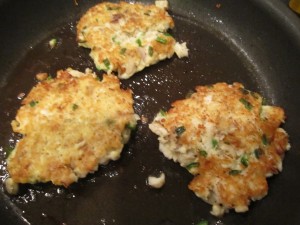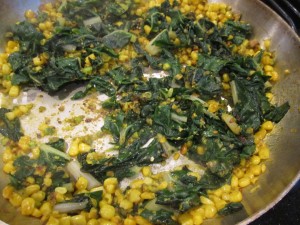 Tilapia Burger with Smashed Yams and Greens
Tilapia Burger with Smashed Yams and Greens
According to the United Nations, The Democratic Republic of Congo (DRC) has the lowest Human Development Index in the world, and the lowest Gross National Income per Capita in the world. With a population of almost 70million, that’s a lot of people living in poverty. This is despite the fact the DRC has, according to the CIA World Factbook, “vast potential wealth” in the form of huge mineral reserves. The history of DRC involves lots of corruption and much upheaval. The name alone changed 5 times in the 20th century. The territory was name Belgian Congo in 1908 when the Belgians took over, then changed to Republic of Congo in 1960 when they gained independence from Belgium. Unfortunately, their neighbor had chosen the same name, so that got confusing. For a while it was Congo-Léopoldville, then Democratic Republic of Congo, then Zaire, then back to Democratic Republic of Congo in 1997. Since independence, there has been rampant government corruption, which is what most people blame the current economic situation on. There’s also been fighting with neighbors, human trafficking, HIV/Aids and a number of other nasty infectious diseases, and, well, I think you get the picture…
What the Congolese lack in terms of the official economy, is offset somewhat by the fact that they live in a country with fertile soil and access to fresh water fish from the rivers. While it is estimated by the World Food Programme that DRC has a food deficit around 30-40%, this is mainly due to human factors interfering with food production and distribution, rather than inhospitable geography or climate. So, the food that is available is stretched and cooked in ways that maximize the ability to feed families.
Fufu is the most commonly eaten starch. It’s basically cassava root boiled down and mashed, then rolled into balls and dipped in stews. My local store didn’t have cassava, so I substituted white yams, which is another starch commonly, found in Africa. I just made a simple mash but because the yams are a bit sweet, I cut them with a little bit of yogurt. I doubt that a lot of yogurt is consumed in DRC but sometimes you’ve got to just go with the flavor rather than authenticity.
As for the protein, tilapia again seemed a good choice as an inexpensive fresh water fish. By adding some millet flour and peppers, you can get five patties out of the mixture, or four really big patties.
Another great source of protein that doesn’t cost much is nuts. I used pistachios, but you could use peanuts if you want a less pricey alternative. If we were in the DRC, we would probably have a spicy vegetable stew, but we’ve done that for other African countries and I wanted something a little lighter to go with the fish. So I took some greens, (I’m told Swiss chard tastes a like cassava greens) and some corn and kept the topping simple, allowing the palm oil flavor to do the heavy lifting. Red palm oil is a unique flavor that is used extensively in African cooking. You can order it online; just try to find it in a jar rather than a bottle. The oil is a semi solid at room temperature, so when winter hits and the kitchen gets chilly, it’s really hard to get the oil out of a bottle. Also, I’ve mentioned it before, but it bears repeating, the oil is very red and very staining – don’t wear white when cooking or eating anything prepared with it. If you can’t get red palm oil, you can just use peanut oil, but you will lose a flavor component that doesn’t really have a substitute.
Overall we were pleasantly surprised that this dish had just an undertone of spice and overall tasted very fresh and light. The sweetness of the corn was really nice with the red palm oil, and I was careful to keep the oil to a fairly small amount so that it wouldn’t weigh down the greens. The fishcake was another successful combination with the nuttiness of the millet flour balanced by the tartness of the jalapenos. Even the sweetness of the mashed yams somehow worked with the rest of the dish and it all pulled together. I would say this is a great option for the warmer weather, it lacked the heartiness that I associate with cold weather food, but it definitely would be a good alternative in the spring or if you just love fish.
Thanks to my loyal readers for the tips on pistachios and tilapia and of course the wealth of information on millet. The comments from African recipes have been some of the best, I am thrilled to have readers who know so much about the food continuing to follow and comment. Enjoy the burger!
Democratic Republic of the Congo burger
1 pound tilapia fillets (or other white fish)
3 small jalapenos diced fine
1 large shallot diced fine
Juice of ½ a lemon
Kosher salt
Ground black pepper
¼ cup millet flour
1 large egg lightly beaten
2 Tablespoons peanut oil
Mashed Yams (recipe below)
Sliced tomato
Chard Greens with Corm (recipe below)
Salt and pepper the fish fillets. In a large non-stick skillet, heat 1 Tablespoon of the peanut oil. Add the fish fillets and cook over medium high heat for 2-3 minutes until cooked about half way through. Turn the fish, add shallots and ½ of the chopped jalapeno and cook until fish is just done. Remove and sprinkle with lemon juice. Let fish cool. Using a fork, break up the fish into flakes. Add millet flour, the remaining jalapenos and salt to taste. Add egg and mix evenly. Divide into 4-5 portions and form patties. Place the patties on plastic wrap and refrigerate for at least one hour.
In a large non-stick skillet, heat the remaining 1 Tablespoon of peanut oil until shimmering. Add the fish cakes and cook until golden then turn and cook until heated through (2-3 minutes per side).
Place the cooked fish cakes on the Mashed Yams, add tomato slices to each then top with the Chard Greens with Corn. Serve hot.
Mashed Yams
2 white yams (don’t use orange sweet potatoes, they are too sweet, you can substitute cassava or potato)
6 dried bird chilies (any hot chili can be substituted)
Kosher salt
1 Tablespoon Greek yogurt
Bring salted water to a boil. Peel the yams and cut into chunks. Add the yams to the boiling water along with the bird chilies. Boil until fork tender. Drain, mash, add salt and yogurt to taste.
Chard Greens with Corn
1 cup corn (fresh is great, but the season is over here, so frozen worked just fine, thaw the corn first if you use frozen)
Kosher salt
4 cups Swiss chard leaves chopped
¼ cup water
½ cup unsalted pistachios ground fine
1 Tablespoon red palm oil
Cayenne pepper to taste
In a medium skillet, heat the palm oil until melted and evenly distributed. Add the corn and salt and cook over medium high until just heated through. Add the chard leaves, cover and cook until wilted. Add water and simmer over low heat for 15 minutes. Add the pistachio nuts and cayenne to taste. Serve warm.
©Copyright 2011 Linda Monach





But it’s fish 🙁
fish is yummy, move past your roots and try something new! xo
Pingback: 10 Instagram-Worthy Congolese Dishes